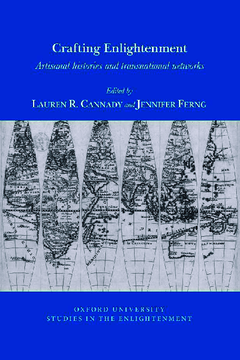
L. R. Cannady, J. Ferng (eds), Crafting Enlightenment. Artisanal Histories and Transnational Networks
Lauren R. Cannady and Jennifer Ferng (eds),
Crafting Enlightenment: Artisanal Histories and Transnational Networks,
collection "Oxford University Studies inthe Enlightenment", 2021.
EAN13 : 9781800857841.
A ground-breaking volume examining the transnational conditions of the European Enlightenment, Crafting Enlightenment argues that artisans of the long eighteenth-century on four different continents created and disseminated ideas that revolutionized how we understand modern-day craftsmanship, design, labor, and technology. Starting in Europe, this book journeys through France across the Atlantic Ocean to the Americas and then on to Asia and Oceania. Highlighting diverse identities of artisans, the authors trace how these historical actors formed networks at local and global levels to assert their own forms of expertise and experience. These artisans – some anonymous, eminent, and outside the margins – translated European Enlightenment thinking into a number of disciplines and trades including architecture, botany, ceramics, construction, furniture, gardening, horology, interior design, manuscript illustration, and mining.
*
“Scholars today are rewriting histories of the eighteenth century to be more ambitious in scale and inclusive in scope. As a discipline whose foundations have traditionally been located in the European Enlightenment, art history has long defined itself through exclusive canons of “artists” and “art” that have valorised certain individuals and objects at the expense of others. Recent directives to decolonize art history, as well as architectural history, demonstrate that these disciplines seek to credit those who labour as part of art- and knowledge-making processes.”
(Read the editors’ accompanying blog post)
*
Contents
List of figures
Acknowledgments
Introduction: assembling artisanal identities across geographies
I. Envisioning artisanal histories
Chapter 1: Sovereign Sun King
Chapter 2: Visualizing urban festivals in the Ottoman Empire: a comparison of the sixteenth and eighteenth centuries
Chapter 3: Telling artisanal time
II. Collaborative objects
Chapter 4: The secret to success: urbanization and luxury decoration at the place Louis-le-Grand
Chapter 5: The Spanish colonial world in microcosm: a Puebla desk-and-bookcase
Chapter 6: Artisanal agency, anonymity, and power
III. Religion and the commerce of empire
Chapter 7: Mark of disgrace or matter of politeness? Materiality, trust, and expectation in early-eighteenth-century Virginia
Chapter 8: Interregna: the Société des arts and the scale of time
Chapter 9: Confessional complications in maritime trade
IV. Corporeal ecologies
Chapter 10: A “small” story of the jasmine flower in the age of global botany
Chapter 11: Fire walk with me: tales of artisanal body (parts) and innovation in early modern China
Chapter 12: Grounded terrains and vertical landscapes in eighteenth-century Asia
V. Enlightenment technologies
Chapter 13: Craft knowledge in the age of encyclopedism
Chapter 14: Miniature domination: mining the worlds of goldfields jewelry and emu eggs
Chapter 15: Artisans as thinkers in the early modern world
Summaries
Bibliography
Index
*
Lauren R. Cannady, assistant clinical professor in University Honors at the University of Maryland, is a historian of early modern art and architecture with an interest in intellectual and cultural history. Her previous publications include analyses of early modern garden patterns and French aesthetic philosophy, and her current project is a book on northern European gardens as sites of knowledge production and transmission.
Jennifer Ferng is Senior Lecturer in Architecture and Postgraduate Director at the University of Sydney. She received her PhD from MIT. Her second co-edited book Land Air Sea will address how architecture and environment(s) in the early modern era forecasted contemporary issues related to climate change and sustainability.